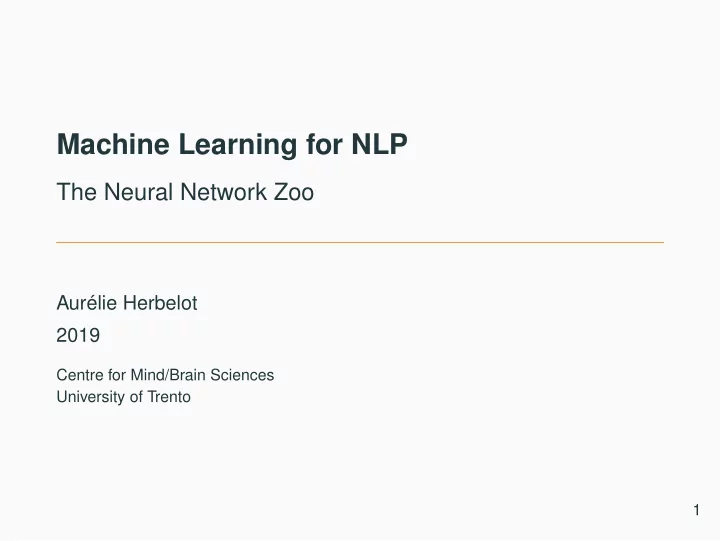

Machine Learning for NLP The Neural Network Zoo Aurélie Herbelot 2019 Centre for Mind/Brain Sciences University of Trento 1
The Neural Net Zoo http://www.asimovinstitute.org/neural-network-zoo/ 2
How to keep track of new architectures? • The ACL anthology: 48,000 papers, hosted at https://aclweb.org/anthology/. • arXiv on Language and Computation: https://arxiv.org/list/cs.CL/recent. • Twitter... 3
Today: a wild race through a few architectures 4
CNNs • Convolutional Neural Networks: NNs in which the neuronal connectivity is inspired by the organization of the animal visual cortex. • Primarily for vision but now also used for linguistic problems. • The last layer of the network (usually of fairly small dimensionality) can be taken out to form a reduced representation of the image. 5
Convolutional deep learning • Convolution is an operation that tells us how to mix two pieces of information. • In vision, it usually involves passing a filter (kernel) over an image to identify certain features. 6
CNNs: what for? • Identifying latent patterns in a sentence: syntax? • CNNs can be used to induce a graph similar to a syntactic tree. Kalchbrenner et al, 2014: https://arxiv.org/pdf/1404.2188.pdf 7
Graph2Seq architectures • Graph2Seq: take a graph as input and convert it into a sequence. • To embed a graph, we record the neighbours of a particular node and direction of connections. Xu et al, 2018: https://arxiv.org/pdf/1804.00823 8
Graph2Seq: what for? Language generation: the model has structured information from a database and needs to generate sentences describing operations over the structure. 9
GCNs • Graph Convolutional Networks: CNNs that operate on graphs. • Input, hidden layers and output all encapsulate graph structures. 10
GCNs: what for? • Abusive language detection. • Represent an online community as a graph and learn the language of each node (speaker). Flag abusive speakers. Mishra et al, 2019: https://arxiv.org/pdf/1904.04073 11
Hierarchical Neural Networks • Hierarchical Neural Networks: we have seen networks that take a graph as input. HNNs are shaped as acyclic graphs. • Each node in the graph is a network. Yang et al, 2016: https://www.aclweb.org/anthology/N16-1174 12
Hierarchical Networks: what for? Document classification: the model attends to words in the document that it thinks are relevant to classify it into one or another class. 13
Memory Networks • Memory Networks: NNs with a store of memories. • When presented with new input, the MN computes the similarity of each memory to the input. • The model performs attention over memory cells. Sukhbaatar et al, 2015: https://papers.nips.cc/paper/5846-end-to-end-memory-networks.pdf 14
Memory Networks: what for? Textual question answering: embed sentences as single memories. When presented with a question about the text, retrieve the relevant sentences. 15
GANs • Generative Adversarial Networks: two networks working in collaboration. • A generative network and a discriminating network. • The discriminator works towards distinguishing real data from generated data while the generator learns to fool the discriminator. 16
GANs: what for? • Generating images from text captions. • Two-player game: the discriminator tries to tell generated from real images apart. The generator tries to produce more and more realistic images. Reed et al, 2016: http://jmlr.csail.mit.edu/proceedings/papers/v48/reed16.pdf 17
Siamese Networks • Siamese Networks: learn to differentiate between two inputs. • Use the same weights for two different input vectors and compute loss as a measure of contrast between the outputs. • By getting a measure of contrast, we also get a measure of similarity. https://hackernoon.com/one-shot-learning- with-siamese-networks-in-pytorch- 8ddaab10340e 18
Siamese Networks: what for? • Sentence similarity. • By sharing the weights of two LSTMs, and combining their output via a contrastive function, we force them to concentrate on features that help assessing (dis)similarity in meaning. https://www.aaai.org/ocs/index.php/AAAI/AAAI16/paper/ viewPDFInterstitial/12195/12023 19
VAEs • AutoEncoders: derived from FFNNs. They compress information into a (usually smaller) hidden layer (encoding) and reconstruct it from the hidden layer (decoding). • Variational Auto-Encoders: an architecture that learns an approximated probability distribution of the input samples. Bayesian from the point of view of probabilistic inference and independence. 20
VAEs: what for? • Model a smooth sentence space with syntactic and semantic transitions. • Used for language modelling, sentence classification, etc. Bowman et al, 2016: https://www.aclweb.org/anthology/K16-1002 21
DAEs • Denoising AutoEncoders: classic autoencoders, but the input is noisy. • The goal is to force the network to look for the ‘real’ features of the data, regardless of noise. • E.g. we might want to do picture labeling with images that are more or less blurry. The system has to abstract away from details. 22
DAEs: what for? Fevry and Fang, 2018: https://arxiv.org/pdf/1809.02669 Summarisation: since the AE has learnt to abstract away from detail in the course of denoising, it becomes good at summarising. 23
Markov chains • Markov chains: given a node, what are the odds of going to any of the neighbouring nodes? • No memory (see Markov assumption from language modeling): every state depends solely on the previous state. • Not necessarily fully connected. • Not quite neural networks, but they form the theoretical basis for other architectures. 24
Markov chains: what for? • We will talk more about Markov chains in the context of Reinforcement Learning! • For now, let’s note that BERT is a little Markov-like... Wang and Cho, 2019: https://arxiv.org/pdf/1902.04094 https://jalammar.github.io/illustrated-bert/ 25
What you need to find out about your network 1. Architecture: make sure you can draw it, and describe each component! 2. Shape of input and output layer: what kind of data is expected by the system? 3. Objective function. 4. Training regime. 5. Evaluation measure(s). 6. What is your network used for? 26
Recommend
More recommend